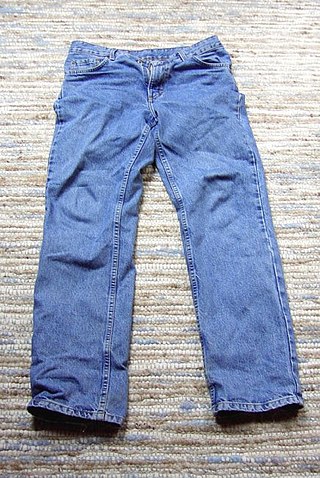
Jeans are a type of pants or trousers made from denim or dungaree cloth. Often the term "jeans" refers to a particular style of trousers, called "blue jeans", with the addition of copper pocket rivets added by Jacob W. Davis in 1871 and patented by Davis and Levi Strauss on May 20, 1873. Prior to the patent, the term "blue jeans" had been long in use for various garments, constructed from blue-colored denim.
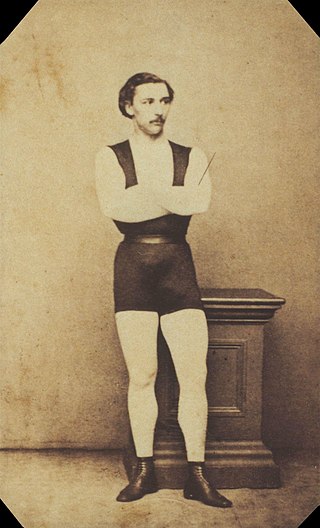
A leotard is a unisex skin-tight one-piece garment that covers the torso from the crotch to the shoulder. The garment was made famous by the French acrobatic performer Jules Léotard (1838–1870). There are sleeveless, short-sleeved, and long-sleeved leotards. A variation is the unitard, which also covers the legs.

A skin-tight garment is a garment that is held to the skin usually by elastic tension using some type of stretch fabric. Commercial stretch fabrics ('elastomerics') such as spandex or elastane came onto the market in 1962, and revolutionized many areas of the clothing industry. A wide variety of clothing may be made to be skin-tight, and it is common for clothing to be skin-tight for some uses, such as in stockings, bodystockings, swimsuits and women's bras.
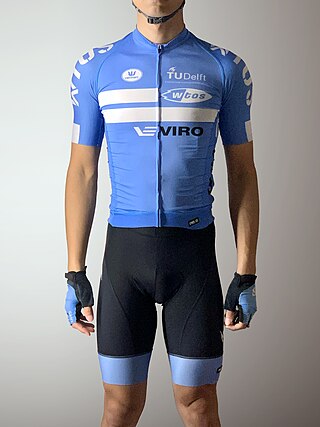
Spandex, Lycra, or elastane is a synthetic fiber known for its exceptional elasticity. It is a polyether-polyurea copolymer that was invented in 1958 by chemist Joseph Shivers at DuPont.

Tights are a kind of cloth garment, most often sheathing the body from the waist to the toe tips with a tight fit, hence the name. They come in absolute opaque, opaque, sheer and fishnet styles — or a combination, such as the original concept of the American term pantyhose with sheer legs and opaque panty.
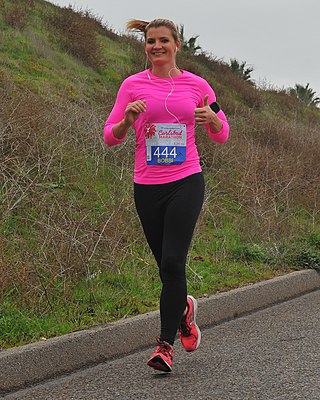
Leggings are several types of leg attire that have varied through the years. Modern usage from the 1960s onwards has come to refer to elastic close-fitting high-rise garments worn over the legs typically by women, such as leg warmers or tights. Usage from the 18th century refers to men's wear usually made of cloth or leather that is wrapped around the leg down to the ankle. In the 19th century, leggings usually referred to infants' leg clothing that were matched with a jacket, as well as leg-wrappings made of leather or wool and worn by soldiers and trappers. Leggings prominently returned to women's fashion in the 1960s, drawing from the form-fitting clothing of dancers. With the widespread adoption of the synthetic fibre Lycra and the rise in popularity of aerobics, leggings came to further prominence in the 1970s and 1980s, and eventually made their way into streetwear. Leggings are a part of the late 2010s into the 2020s athleisure fashion trend of wearing activewear outside sporting activities and in casual settings.

Competitive swimwear refers to the swimsuit, clothing, equipment, and accessories used in the aquatic sports of swimming, diving, synchronized swimming, triathlon, and water polo.
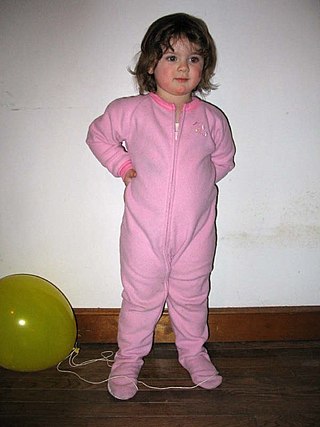
The blanket sleeper is a type of especially warm sleeper or footie pajama worn primarily during the winter in the United States and Canada. The garment is worn especially by young children.
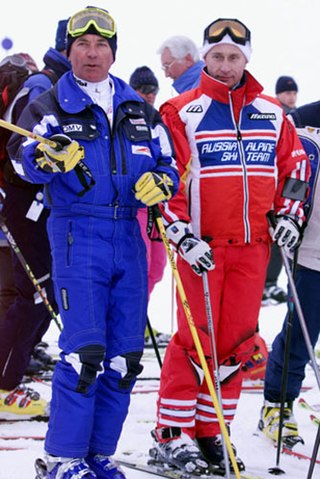
A ski suit is a suit made to be worn over the rest of the clothes when skiing or snowboarding. A ski suit made for more casual winter wear outdoors may also be called a snowsuit [ˈsnoʊˌsut] and are often used by children as everyday outerwear in the winter season. Some suits are specifically made for snowboarders but most are used by either skiers or snowboarders regardless of the style.

Breeches are an article of clothing covering the body from the waist down, with separate coverings for each leg, usually stopping just below the knee, though in some cases reaching to the ankles. Formerly a standard item of Western men's clothing, they had fallen out of use by the mid-19th century in favour of trousers.

Wide-leg jeans, colloquially called baggy pants, are a style of clothing that were popular from the early 1980s to the 2010s.

Cycling shorts are short, skin-tight garments designed to improve comfort and efficiency while cycling.

Fashion of the 1980s was characterized by a rejection of 1970s fashion. Punk fashion began as a reaction against both the hippie movement of the past decades and the materialist values of the current decade. The first half of the decade was relatively tame in comparison to the second half, which was when apparel became very bright and vivid in appearance.

A denim skirt, sometimes referred to as a 'jean skirt' or 'jeans skirt', is a skirt made of denim, the same material as blue jeans. Denim skirts come in a variety of styles and lengths to suit different populations and occasions. For example, full-length denim skirts are commonly worn by women whose religious beliefs prohibit them from wearing trousers, including Orthodox Jews, some Muslims, Mennonites, and Pentecostals, among others. Shorter skirts made of denim are commonly worn by teenagers and young adults.

Slim-fit pants or skinny jeans are tight trousers that have a snug fit through the legs and end in a small leg opening that can be anywhere from 9" to 20" in circumference, depending on size. Other names for this style include drainpipes, stovepipes, tight pants, cigarette pants, pencil pants, skinny pants, gas pipes, skinnies, and tight jeans.

Clothing fetishism or garment fetishism is a sexual fetish that revolves around a fixation upon a particular article or type of clothing, a particular fashion or uniform, or a person dressed in such a style.
A back closure is a means for fastening a garment at the rear, such as with a zipper, hooks-and-eyes or buttons. Back closures were once common on Western female clothing, but have recently become less so, especially on female casual and business attire. They continue, however, to be widely used in underwear, formal wear and specialized clothing. Back closures are also common in garments for infants and toddlers.

Trousers, slacks, or pants are an item of clothing worn from the waist to anywhere between the knees and the ankles, covering both legs separately. In the United Kingdom, the word pants generally means underwear and not trousers. Shorts are similar to trousers, but with legs that come down only to around the area of the knee, higher or lower depending on the style of the garment. To distinguish them from shorts, trousers may be called "long trousers" in certain contexts such as school uniform, where tailored shorts may be called "short trousers" in the UK.

A swim brief or racing brief is any briefs-style male swimsuit such as those worn in competitive swimming, diving and water polo. The popularity of the Australian Speedo brand racing brief has led to the use of its name in many countries around the world to refer to any racing brief, regardless of the maker. Occasionally, the speedo genericized trademark is applied to square cut swimsuits, but in general the generic term is used in reference to swimming briefs. Swim briefs are also referred to as competition briefs, swimming trunks, bathers, togs, racer bathers, posing briefs, racing briefs, and colloquially in Australia, New Zealand, and the United Kingdom as budgie smugglers.

Yoga pants are high-denier hosiery reaching from ankle to waist, originally designed for yoga as exercise and first sold in 1998 by Lululemon, a company founded for that purpose. They were initially made of a mix of nylon and Lycra; more specialised fabrics have been introduced to provide moisture-wicking, compression, and odour reduction.



















